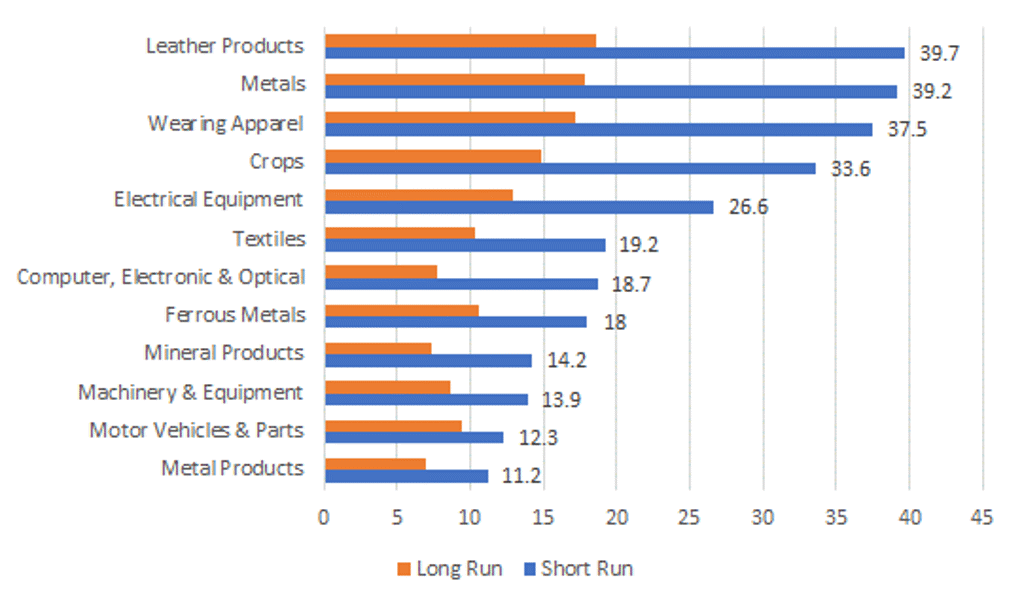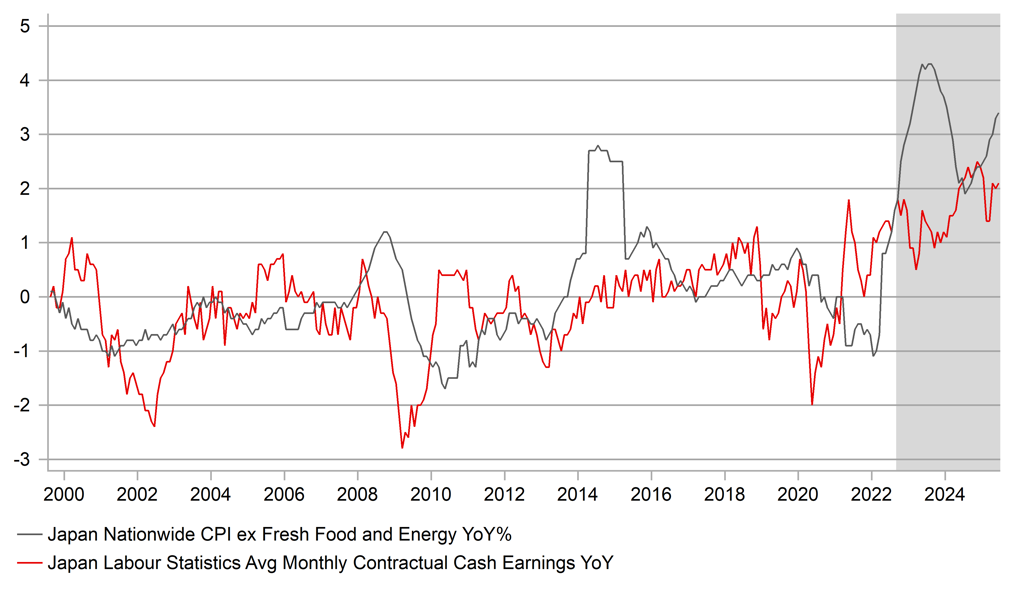Economic risks will turn tariff risks to a USD negative again
USD: Weakening economy will see tariff concerns rise again
The first half of the year saw the US dollar sell off sharply and tariff uncertainty was certainly a factor in that selling given the concerns over the economic damage done. But certain factors driving that dollar selling started to change back in mid-April – firstly we saw a quick reversal of the Liberation Day tariffs which was seen as President Trump quickly altering course due to the financial market reaction. Secondly, that happened again when President Trump denied he was planning to fire Fed Chair Powell as the UST bond market was tanking. His denial brought back stability. Third, the employment data, particularly the NFP data in May, June and July indicated labour market resilience that eased fears over tariff damage to the economy.
These three developments helped the dollar stabilise, and while the dollar did hit new lows in early July, has since recovered on relief that trade deals have been done and reciprocal tariff rates are not as bad as initially feared. The DXY index today is above the levels that were trading on occasions in April. So while new lows for the dollar were hit in June, since mid-April, the US dollar has been much more stable than in the period from January to April. On an intra-day basis, the dollar fell 11% from the high in January to the low in April. From that low in April, the dollar has traded 4% higher and 1.7% lower and is today is 0.7% higher from the low in April.
But will this relative stability turn into a renewed US dollar rally or a renewed extension of US dollar weakness? The factors mentioned above that helped stall the dollar sell-off are now returning. Tariffs may not be as bad as feared but investors are likely to see them as still pretty bad. The idea that these new agreed levels and “trade deals” mean less uncertainty could also be questioned quickly. The Swiss Finance Minister and President – Karin Keller-Sutter – is heading to Washington to negotiate down its 39% tariff rate. Japan’s chief trade negotiator – Akimasa Akazawa – is in Washington to try and seek clarification on the timing of the implementation of the deal and the US investment fund deal that lead to Japan getting its auto tariff rate lowered from 25% to 15%. And President Trump yesterday confirmed on CNBC that tariffs on pharmaceuticals and semi-conductor chips would be announced “within the next week or so” and while the pharma tariff will start small, within a year or a year-and-a-half would hit 150% and then 250%. It’s difficult to expect investor optimism over the limited impact of tariffs to continue. The chart above highlights the estimates from Yale University’s estimated price increases over the short-run and long-run for certain goods.
The second factor looks more serious now than back in April. While Trump may not fire Powell, having his pick to take over on the Board of Governors is now set to happen much sooner than expected that is likely to create much greater concern over political interference. Finally, the jobs market no longer looks resilient. Three consecutive NFP prints below 100k usually signals recession while the ISM Services Employment index in data released yesterday fell just like the manufacturing index on Friday. White House interference in the BLS by firing its head following a disappointing report could also be hugely damaging to sentiment and is just as concerning as the attempts to undermine Fed independence. Continued positioning liquidation of US dollar shorts is likely playing a role in curtailing renewed dollar selling but renewed weakness ahead looks more likely at this stage.
ESTIMATED TARIFF IMPACT ON CERTAIN PRICES OF GOODS / CATEGORIES

Source: The Budget Lab, Yale University; tariffs including 1st August levels
JPY: Nominal wage growth undermined by still high inflation
Wage data for June was released in Japan today and there has been limited market impact in FX or rates from the renewed acceleration in annual growth rates. The headline cash earnings annual growth rate picked up from 1.0% in May to 2.5% in June and while weaker than what was expected, was a big enough jump to ensure the BoJ can maintain the view of wage growth adding to the prospect of achieving its price stability goal. The pick-up was helped by a summer bonus increase of 3.0% YoY. The base salary for full-time workers stripping out sample changes increased 2.3% YoY and will be seen by the BoJ as justification for maintaining its guidance that the economy is unfolding as expected that will therefore require further hikes going forward. However, with nationwide inflation rates still elevated, the level of real wage growth remained negative, at -1.3% in June. That fact remains a crucial element of why the cost of living crisis continues to undermine support for the government.
No surprise then that Taro Kono, one of the senior LDP members and a runner in the leadership election last year, that was won by PM Ishiba, today called more explicitly for the BoJ to tighten its monetary stance. Kono stated that the government should have reached an agreement with the BoJ before the upper house elections for the BoJ to hike interest rates in return for the government committing to cutting government spending and making stronger efforts to bring the budget into balance more promptly. Kono was clear that what ultimately is needed is a stronger yen to help bring down inflation. These comments from Kono we believe are signs of the building domestic pressure that the BoJ will come under to become less cautious and take action that will bring inflation down more notably. The chair of the Japan Association of Corporate Executives last week stated on Bloomberg TV that the weak yen was damaging the economy.
The yen remains the top performing G10 currency in August to date following the sharp drop in USD/JPY following the payrolls report and while we are bullish yen over the medium-term, there remain some short-term risks that is curtailing follow-through yen buying. The position of PM Ishiba remains uncertain while the caution of the BoJ at last week’s policy meeting leaves investors concerned. JGB market instability risks are also a factor and a key test comes tomorrow with the 30-year JGB auction.
CORE-CORE NATIONWIDE CPI ABOVE WAGE GROWTH FOR NEARLY 3YRS

Source: Macrobond; Bloomberg & MUFG GMR
KEY RELEASES AND EVENTS
|
Country |
BST |
Indicator/Event |
Period |
Consensus |
Previous |
Mkt Moving |
|
EC |
08:30 |
IHS S&P Global Construction PMI (MoM) |
Jul |
-- |
45.2 |
! |
|
IT |
09:00 |
Italian Industrial Production (MoM) |
Jun |
-0.1% |
-0.7% |
! |
|
UK |
09:30 |
Construction PMI |
Jul |
49.2 |
48.8 |
!!! |
|
EC |
10:00 |
Retail Sales (YoY) |
Jun |
2.6% |
1.8% |
! |
|
EC |
10:00 |
Retail Sales (MoM) |
Jun |
0.4% |
-0.7% |
! |
|
US |
12:00 |
MBA Mortgage Applications (WoW) |
-- |
-- |
-3.8% |
! |
|
US |
17:45 |
FOMC Member Daly Speaks |
-- |
-- |
-- |
!!! |
|
US |
18:00 |
10-Year Note Auction |
-- |
-- |
4.362% |
!!! |
|
US |
19:00 |
Fed Collins Speaks |
-- |
-- |
-- |
!!! |
|
US |
19:00 |
Fed Governor Cook Speaks |
-- |
-- |
-- |
!!! |
|
US |
21:10 |
FOMC Member Daly Speaks |
-- |
-- |
-- |
!! |
Source: Bloomberg & Investing.com
